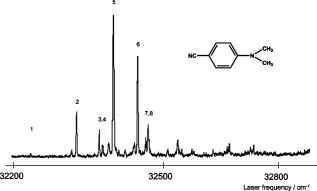A.E. Nikolaev, G. Myszkiewicz, G. Berden, W.L. Meerts, J.F. Pfanstiel, and D.W. Pratt.
J. Chem. Phys. 122 (2005) 084309.
G. Berden, J. van Rooy, W.L. Meerts, and K.A. Zachariasse.
Chem. Phys. Lett. 278 (1997) 373-379
 We report the observation at high resolution of seven vibronic bands that appear within ~200 cm-1 of the electronic origin in the S1-S0 fluorescence excitation spectrum of 4,4-dimethylaminobenzonitrile (DMABN) in a molecular beam. Surprisingly, each band is found to be split into two or more components by a (coordinated) methyl group tunneling motion which significantly complicates the analysis. Despite this fact, high quality fits of each of the bands have been obtained, from which the rotational constants, inertial defects, torsion-rotation interaction constants, methyl group torsional barriers, and transition moment orientations of DMABN in both electronic states have been determined. The data show that DMABN is a slightly pyramidalized (~1°) but otherwise (heavy-atom) planar molecule in its ground S0 state, and that its electronically excited S1 state has both a more pyramidalized (~3°) and twisted (~25°) dimethylamino group. Large reductions in the methyl group torsional barriers also show that the S1S0 electronic transition is accompanied by significant charge transfer from the nitrogen atom to the pi* orbitals of the aromatic ring. Thereby established is the participation of all three vibrational coordinates in the dynamics leading to the "anomalous" emissive behavior of DMABN in the condensed phase.
We report the observation at high resolution of seven vibronic bands that appear within ~200 cm-1 of the electronic origin in the S1-S0 fluorescence excitation spectrum of 4,4-dimethylaminobenzonitrile (DMABN) in a molecular beam. Surprisingly, each band is found to be split into two or more components by a (coordinated) methyl group tunneling motion which significantly complicates the analysis. Despite this fact, high quality fits of each of the bands have been obtained, from which the rotational constants, inertial defects, torsion-rotation interaction constants, methyl group torsional barriers, and transition moment orientations of DMABN in both electronic states have been determined. The data show that DMABN is a slightly pyramidalized (~1°) but otherwise (heavy-atom) planar molecule in its ground S0 state, and that its electronically excited S1 state has both a more pyramidalized (~3°) and twisted (~25°) dimethylamino group. Large reductions in the methyl group torsional barriers also show that the S1S0 electronic transition is accompanied by significant charge transfer from the nitrogen atom to the pi* orbitals of the aromatic ring. Thereby established is the participation of all three vibrational coordinates in the dynamics leading to the "anomalous" emissive behavior of DMABN in the condensed phase.

